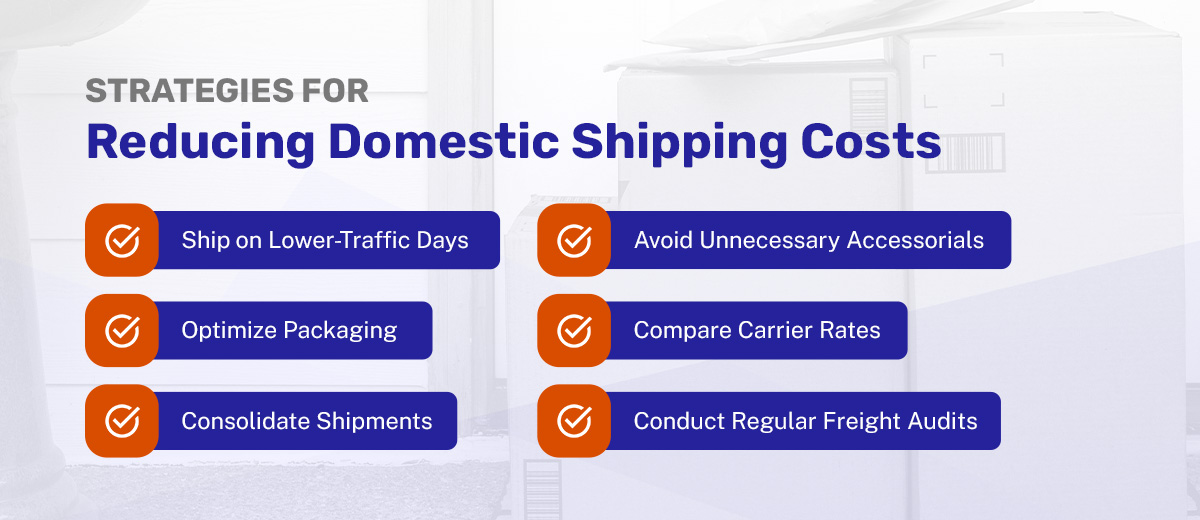Reducing Costs on Domestic LTL and Parcel Expenses in Light of Increasing Tariff Costs
Posted on October 13, 2025
Written by Mickey Powers
Rising domestic LTL and parcel expenses are a crisis for manufacturing, retail and e-commerce leaders. If your organization doesn’t mitigate the impact of tariffs on domestic transportation, the ripple effects may include budgetary strain and reduced profit margins. Fortunately, you can explore several options to reduce your domestic shipping costs.
This guide will explain how to offset tariff costs with parcel & LTL contract optimizations and other cost-effective strategies.
Understanding the Impact of Tariffs on Domestic Shipping
Countries levy tariffs on imported goods to generate revenue and make foreign products less competitive, thereby protecting domestic industries. As more companies reshore operations to sidestep these costs, demand for domestic logistics rises — driving up shipping expenses across the U.S. supply chain.
Adverse Effects of Increasing Tariff Costs
High tariffs result in high LTL shipping costs, adversely affecting businesses and consumers.
- Increased operational cost: While tariffs should give local businesses a competitive advantage over their foreign counterparts, they create additional operational costs, especially for those that rely on imported materials for production.
- Reduced profit margins: Tariffs can force businesses to reduce profit margins to counterbalance additional costs or increase prices, adversely affecting demand.
Reallocation of Funds — The Key to Offsetting Increased Tariff Costs
Reallocating business funds is a surefire way to mitigate the adverse effects of rising tariffs. This strategy helps you reallocate transportation savings for tariffs, absorbing costs without passing them to customers.
A prime example is adopting more cost-effective domestic shipping options. The resulting savings may not perfectly offset tariff increases, but every little bit helps.
What Are Parcel Contract Optimizations?
Review parcel & LTL pricing before signing any contract with your domestic carriers. Parcel & LTL contract optimization can improve the terms of your agreement and help you negotiate better, more affordable rates. If you skim the paperwork without confirming specific details, you may agree to prices that adversely affect your business in the long run. Here are some details to look for in your contract’s fine print.
- DIM divisor (parcel): Check the carrier’s proposed factors for calculating each package’s dimensional weight.
- Minimum charge: This detail represents the minimum amount the carrier will charge you to send any package or shipment. Utilization of regional carriers or negotiating a lower minimum charge is advantageous in both parcel and LTL.
- Discounts: Are your discounts as aggressive as they should be? Utilize an independent 3rd party to understand how your discounts compare to what is being offered in the marketplace (benchmarks).
- Earned discount structure(parcel): You may qualify for discounts based on your shipping volume over a specified period. The carrier’s earned discount structure will outline the qualifications and incentive amounts they offer.
- Accessorials: Scrutinize a carrier’s proposed additional charges — they can increase the cost of your LTL & Parcel shipping. The carriers, both parcel & LTL, are willing to offer concessions off their published accessorial charges, even including fuel surcharges.
Contract optimization can help with tariff mitigation by pinpointing opportunities to save and reallocate money. Having specialized experts review and negotiate parcel contracts gives you a competitive edge.
Strategies for Reducing Domestic Shipping Costs
Less-than-truckload shipping allows you to transport goods without filling entire trucks. To help your business stay competitive and flexible, consider exploring the following strategies for reducing domestic LTL costs.
Ship on Lower-Traffic Days
Though shipping costs fluctuate, timing your shipments can decrease the impact of price spikes. For instance, Mondays and Fridays tend to be higher traffic days for LTL carriers, offering potential savings and better availability, if shipping on lower volume days (this can vary from terminal to terminal). Confirm capacity with your carrier. Filling underused space will simultaneously benefit your bottom line and their operational efficiency. Many LTL carriers now offer “dynamic” pricing based on these imbalances in their linehaul network, take advantage of the carriers that offer this additional pricing methodology.
Optimize Packaging
Efficient packaging is highly influential in managing LTL shipping costs. Bulky or poorly designed packages can waste pallet space and add unnecessary weight, driving up rates. Businesses can optimize load density, streamline handling and reduce shipping expenses by switching to compact, stackable materials.
Consolidate Shipments
Cargo space is a precious resource in LTL shipping, as wasted space means wasted dollars. Consolidating smaller shipments into a single load can significantly reduce costs by minimizing shipments and maximizing trailer use. Consider partnering with other domestic shippers to share space and split costs. Third-party logistics providers can identify compatible partners and coordinate the logistics.
Whether you consolidate internally or through partnerships, success depends on proactive planning and communication. Without these elements, cost-saving opportunities can soon turn into operational headaches.
Avoid Unnecessary Accessorials
While you may not control additional costs imposed by LTL carriers, you can do your part to avoid unnecessary accessorials. Here are some steps you can take to minimize extra costs:
- Provide accurate shipment details to avoid reclassification and reweighing accessorials.
- Promptly schedule pickup and delivery appointments to prevent wait time and detention accessorials.
- Notify receivers beforehand and confirm availability to avoid delivery failures and redelivery fees.
Compare Carrier Rates
Shipping rates vary by carrier. Conduct detailed market research and compare rates before settling for the best and most competitive option. In addition to pricing, you should also consider accessorials, minimum charges and industry averages when choosing a carrier.
Conduct Regular Freight Audits
It’s easy to overlook rate errors and irregularities, especially when you frequently ship high volumes. Such transaction mistakes add up over time, costing you significantly. Spot errors and prevent overcharges by conducting regular freight audits.
When you choose a reliable freight audit provider, you can rest assured that they will review your invoices regularly to ensure they are accurate and in line with your carrier contract.
Maximize Domestic LTL With the Best Prices
With tariffs on the rise, manufacturers and retailers face increased risks of exorbitant domestic shipping costs, which are bad for business and customers. Thankfully, despite rising tariffs, you can still enjoy the best domestic LTL and parcel shipping rates. In addition to taking advantage of the strategies outlined in this article, you should invest in parcel contract optimization solutions to make the most of your contracts.
Broussard Logistics understands the impact of tariffs. To help you, we employ parcel contract strategies for tariff cost reduction. Our process involves supporting contract negotiations, benchmarking freight rates, reviewing contract terms and conditions and providing ongoing data monitoring. Contact us to get started with negotiating best-in-class shipping rates.


